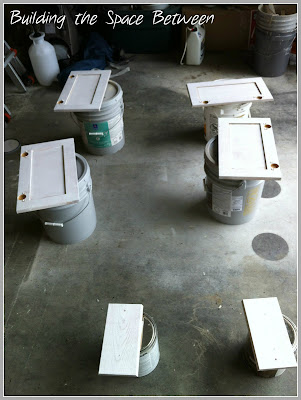 |
| Coming soon with less honey. |
It all began with tape, and lots of it.
 |
| Ugly. |
Normally I like to freehand things when I'm painting with a brush. But I chose to tape around the vanity for two reasons: lots of tight spaces and corners, and ease of cleanup.
 |
| Corner city. |
Normally I like to use Frog Tape. I find that it gives crisper lines than blue painter's tape. But I ran out of Frog Tape and all they had at Home Depot was the blue stuff, so blue it was. I tried to tape as closely as I could to edges and then if I had any overlap (like the flag above), I just trimmed it with my razor scraper. See how well it works?
 |
| Phantom toes. |
Although I taped the edges of the laminate counter top, I didn't bother to cover the whole surface. Any booboos that escape beyond the blue paint (which will be very few, fingers crossed) can be removed with a razor scraper or acetone after the fact.
 |
| Maybe I should just leave it like this. No? |
I also taped the floor. I actually taped two rows out. Unlike laminate counter top, it is a pain in the you-know-where to get paint off vinyl flooring. I was still too lazy for paper or a drop cloth, though.
 |
| Living dangerously. |
After I had prepped the area, I got the paint. I already had three cans of off-the-shelf white paint in the garage.
 |
| Hoarding tendencies. |
Both of the quart cans were semi-gloss, and the Valspar brand was almost empty. Although I'd rather have the durability and look of semi-gloss, I definitely wanted to try a product called Floetrol.
It's designed to work with latex painting projects where you want to avoid brush or roller marks. It raises the dry time for your paint, but allows it to "settle" into any grooves or brush strokes you leave behind. Totally worth a try. The problem was that the directions for mixing the Floetrol specified 8 oz to a gallon of paint. And I wasn't sure that even if I halved the amount of Floetrol, a quart of semi-gloss would be enough to get 2-3 coats on that vanity. So I went with the gallon of satin paint. Good news for me: it's low VOC which means that there's very little painty smell to deal with.
I mixed up the paint and the Floetrol and poured some into a small roller tray. I started by cutting in with a brush in the nooks and crannies.
 |
| Nook. |
 |
| Cranny. |
Then I used a small roller with a dense foam head that is specifically designed for painting doors and cabinets and rolled (as) even (as I could get) coats on all of the larger flat surfaces. Sorry, no pictures of this part. It's hard enough to use a paint roller without having to take a picture with your other hand.
When I was done with the first coat, I felt a sense of terror set in. Everything looked terrible!! I had made a huge mistake! And then I remembered that I felt the same way about our kitchen cabinets after the first coat of paint (which I now love to pieces). So I told myself to calm down, that they'd look better after two coats and I'd love them after three. And then I snapped some pictures.
 |
| After the first coat. |
The doors look misleadingly white in the photo. In real life there's a whole lotta honey still going on. Chalky honey. Ick. See the next picture for reference.
 |
| Eww, chalky. |
And yes, I realized after the fact that I forgot to paint the darn toe kick. And yes, I did just tape up the toilet paper holder. The screws holding it there were so tight that I just couldn't remove it by myself. So I adapted my tactics, ha!
Now I have to wait for 24 hours and then we'll apply another coat of paint. Here's hoping things look less chalky and uneven after the second coat!


No comments:
Post a Comment